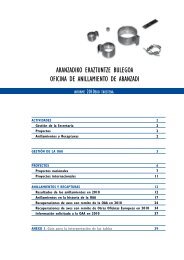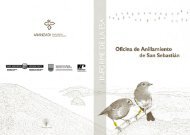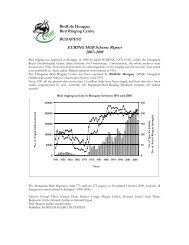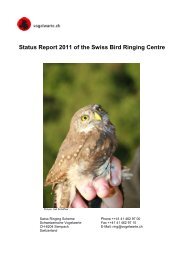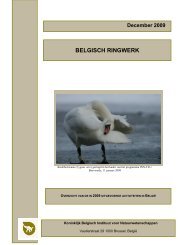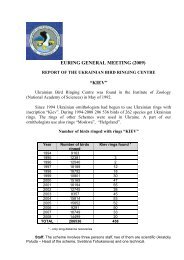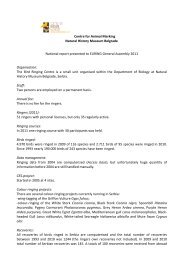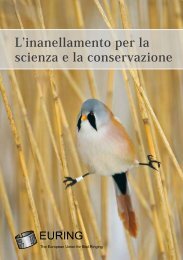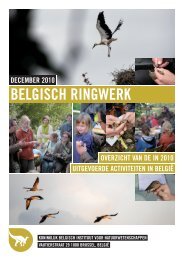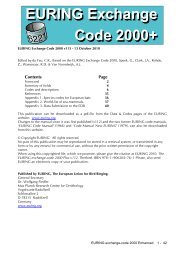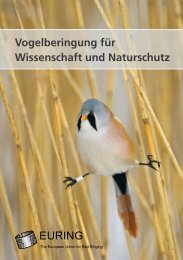Bird Ringing for Science and Conservation - The European Union ...
Bird Ringing for Science and Conservation - The European Union ...
Bird Ringing for Science and Conservation - The European Union ...
- No tags were found...
You also want an ePaper? Increase the reach of your titles
YUMPU automatically turns print PDFs into web optimized ePapers that Google loves.
<strong>Bird</strong> <strong>Ringing</strong> <strong>for</strong> <strong>Science</strong> <strong>and</strong> <strong>Conservation</strong><br />
<strong>Bird</strong> <strong>Ringing</strong> <strong>for</strong> <strong>Science</strong> <strong>and</strong> <strong>Conservation</strong><br />
<strong>Bird</strong>s are personalities<br />
Outst<strong>and</strong>ing individuals<br />
Individuals of the same species <strong>and</strong> sex<br />
have behavioural <strong>and</strong> physiological differences,<br />
even in st<strong>and</strong>ard conditions. In<br />
humans, many of these differences are<br />
treated as expressions of individual variation<br />
in personality. Yet in other animals,<br />
such explanations have often been neglected,<br />
the differences interpreted instead<br />
as either the consequence of inaccurate<br />
measurements or as non-adaptive<br />
variation.<br />
Putting a ring to a bird’s leg makes the<br />
bird a recognizable individual whose individual<br />
life history <strong>and</strong> fate can be followed.<br />
Personalities are general properties<br />
of birds, other animals, <strong>and</strong> humans.<br />
Recent studies in birds suggest that animal<br />
personality can be studied objectively.<br />
Such work has used four approaches in<br />
parallel: (1) descriptive studies, including<br />
the investigation of links among several<br />
behaviours <strong>and</strong> their specificity across situations,<br />
(2) genetic <strong>and</strong> physiological research<br />
on causal mechanisms underlying<br />
relations among several behaviours of the<br />
same profile, (3) ontogenetic studies on<br />
plasticity <strong>and</strong> environmental malleability,<br />
<strong>and</strong> (4) field studies on survival <strong>and</strong> reproduction<br />
towards underst<strong>and</strong>ing how<br />
different types of personality are maintained.<br />
Different personality types may react<br />
differently to environmental changes<br />
<strong>and</strong> may show differential vulnerability<br />
to stress, leading to differences in welfare.<br />
Ultimately, such differences can have major<br />
impacts on individual fitness, response<br />
to environmental change, geographic distribution,<br />
<strong>and</strong> even rates of speciation.<br />
<strong>Ringing</strong> birds individually allows us to follow<br />
even the most exceptional personal<br />
fates.<br />
<strong>The</strong> oldest wild bird ever recorded could<br />
be a Manx Shearwater captured on a little<br />
isl<strong>and</strong> off north Wales. <strong>The</strong> venerable<br />
bird was first captured <strong>and</strong> ringed by ornithologists<br />
in May 1957, when it was fullgrown,<br />
hence between four <strong>and</strong> six years<br />
old. It had been caught in 1961, 1978 <strong>and</strong><br />
2002, when a warden of the Bardsey isl<strong>and</strong><br />
<strong>Bird</strong> Observatory caught the seabird<br />
again. <strong>The</strong> shearwater‘s possible age of 52<br />
years could make it the record holder. Until<br />
now, the world‘s oldest ringed bird was<br />
a US albatross estimated to be over 50.<br />
One of the longest journeys ever recorded<br />
is from a Common Tern ringed<br />
on 27 June 2003 as a nestling in Hälsingl<strong>and</strong><br />
in central Sweden <strong>and</strong> found dead<br />
on 1 December 2003 on Stewart Isl<strong>and</strong> in<br />
New Zeal<strong>and</strong>. If we assume a normal route<br />
from Sweden to South Africa <strong>and</strong> then to<br />
New Zeal<strong>and</strong>, the tern might have covered<br />
25,000 kilometres. Measured as straight<br />
line distances, the tern’s journey is “only”<br />
17,508 km.<br />
<strong>The</strong> rate of migration is quite different<br />
from that attained in flights <strong>for</strong> short<br />
distances. <strong>The</strong> fastest journey is from a<br />
ringed <strong>European</strong> Barn Swallow Hirundo<br />
rustica that flew in 27 days from Umhlange,<br />
Kwa Zulu Natal, South Africa, to<br />
Whitley Bay, United Kingdom.<br />
A Black-headed Gull was ringed as a<br />
fledgling on 29 June 1996 in Hämeenkyrö<br />
county, Pirkanmaa, Finl<strong>and</strong>. <strong>The</strong> metal ring<br />
was sighted with a telescope on the 3 <strong>and</strong><br />
7 January 2000 in Fort Worth, Texas, USA.<br />
<strong>The</strong> bird was back again to its wintering<br />
quarters in Texas on 30 November 2000.<br />
Helmut Kruckenberg<br />
Steve Stansfield<br />
Beat Walser<br />
Special rings <strong>and</strong> various other marks can be used to identify birds at a distance<br />
without needing to catch them again. <strong>The</strong>se White-fronted Geese were marked with<br />
colour neck b<strong>and</strong>s, each individually identified by numbers or letters.<br />
<strong>The</strong> old Manx Shearwater must have<br />
flown at least eight million kilometres<br />
during its long life.<br />
Common Terns migrate between the two<br />
hemispheres <strong>and</strong>, by this, experience both<br />
northern summer <strong>and</strong> austral summer.<br />
2<br />
3



